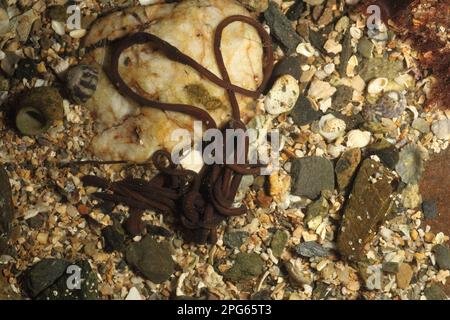
You might be wondering, “Why should I care about bootlace worms?” Well, this topic isn’t just about curiosity; it’s about understanding the vibrant ecosystems surrounding our shores. When the tide goes out, these creatures reveal their secrets, showing us how life thrives even in challenging environments. So grab a cup of coffee and let’s dive into the intriguing world of bootlace worms and their low-tide escapades!
What Are Bootlace Worms?
Bootlace worms are a type of marine worm belonging to the group called *Nemertea* or ribbon worms. You can find them mostly in the northern Atlantic and North Sea, often hiding in tidal zones or under rocks. Their bodies are long and slender, resembling a bootlace—hence the name! What’s truly amazing is their ability to regenerate. If they’re injured, they can quickly grow back lost segments, a bit like how a lizard regrows its tail.
Typically, these worms can be bright colors, from yellow and red to blue or green, which makes them stand out on the ocean floor. While they may look unassuming at first, they play an essential role in their ecosystem. They are predators, feeding on small fish and crustaceans, and help maintain the balance of life in their habitats. So, while they’re not as cuddly as a puppy, bootlace worms are vital players in marine life.
How Do Bootlace Worms Behave at Low Tide?
When the tide goes out, bootlace worms engage in some pretty fascinating behaviors. They often emerge from the sand and mud, stretching and contracting their bodies in search of food. This is a crucial time for them because, during low tide, they might expose themselves to predators like birds and other marine animals. It’s a risky time, but it’s also when they can grab a meal.
You might think of it as a balancing act. Imagine you’re walking a tightrope while trying to gather food. The worms have to be quick and strategic, darting back into their burrows if they sense danger. They use their long, flexible bodies to navigate the changing landscape, showing remarkable adaptability as they explore their world during this temporary dry spell.
The Role of Bootlace Worms in the Ecosystem
Bootlace worms play a significant role in the marine ecosystem. They are not just opportunistic feeders; they also help keep the population of smaller marine creatures in check. By preying on various organisms, they help maintain a balance in the local food web.
Moreover, their presence indicates a healthy environment. A thriving bootlace worm population often points to rich biodiversity in their habitat. When these worms flourish, it suggests that the ecosystem is healthy, which is beneficial for various marine animals, including fish, crabs, and other invertebrates.
In some areas, the decline of bootlace worms could signal environmental issues, such as pollution or habitat destruction. So, keeping an eye on these squiggly creatures is crucial for monitoring the overall health of marine ecosystems.
Challenges That Bootlace Worms Face
Like many marine creatures, bootlace worms face several challenges in their environment. One of the most significant threats is habitat loss. Coastal development, pollution, and climate change can drastically alter the delicate ecosystems that these worms rely on.
Another issue is overfishing. As humans hunt for fish and other marine life, they inadvertently disrupt the food chain, affecting the availability of prey for species like bootlace worms. Additionally, changes in water temperature and salinity due to climate change can impact their health and reproductive patterns, putting pressure on their populations.
In the face of these challenges, it’s essential to promote conservation efforts and responsible fishing practices. Understanding the plight of creatures like bootlace worms reminds us that protecting marine environments benefits us all.
How to Observe Bootlace Worms in Their Natural Habitat
If you’re intrigued and want to see bootlace worms in action, low tide is the perfect time for exploration. Grab your sandals and head to a local tidal zone. Look for muddy or sandy areas, especially around rocks and seaweed. Carefully dig into the sand or gently lift rocks, and you might just spot these fascinating creatures squirming about.
However, it’s important to respect their habitat. Be gentle while observing, as disrupting their environment can cause stress to these creatures. And remember, it’s best to leave them where you found them, as they play a crucial role in their ecosystem.
Taking note of their colors and movements can be a fun way to learn about marine life. You might find it helpful to take a camera or notebook so you can document your findings. You never know; you could become a local expert on bootlace worms!
Bootlace worms may not be the most glamorous creatures in the ocean, but their behavior during low tide is nothing short of captivating. From their long, flexible bodies to their clever adaptations for survival, these worms showcase the incredible diversity of marine life.
Understanding how bootlace worms interact with their environment deepens our appreciation for the natural world. The next time you’re at the beach during low tide, take a moment to appreciate these remarkable creatures and the important role they play in their ecosystems. Who knows? You might just form a new connection with the wonders of the sea!
